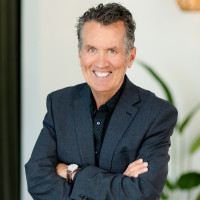Natural products marketing veteran Jeff Hilton reviewed brands pitching their business plans at a recent Nutrition Capital Network event. Here's what he saw there and what he is seeing in the natural products marketplace.

“Omnichannel” has become the most important word in marketing, and the art is evolving quickly as brands seek out new ways to connect with customers who may be in multiple channels on multiple devices, or in multiple stores shopping for the same product on the same day.
BrandHive co-founder Jeff Hilton has been working in branding and marketing in the natural channel for decades. He’s watched the omnichannel era develop and he says he’s still surprised at how fast it's changing.
What common themes did you notice in the marketing strategies for brands pitching at the Nutrition Capital Network this year?
Jeff Hilton: There were a couple common themes. The first one was the growing importance of digital—having digital assets, putting in place things like video and other accessible assets that can help educate. I think the need for education came through as a common theme. I think the idea of having a strong website, having a good sound web presence came through, and then personalization. Of all the presentations, half of them had personalization components as part of it, meaning something that the consumer could do to engage and provide a more personalized outcome. I thought that was fascinating, too.
That personalization is built into the marketing now?
JH: Yes. It’s really got to be part of the offering. I mean it's kind of front and center. I was at a conference in Tucson and everybody's talking about how to make their offerings more custom or allow the consumer to get engaged and make it more custom—what the inputs look like, what the outputs are expected to look like. It's just kind of the buzz. I don't think anybody's figured that out yet, but it's certainly something that everyone's talking about.
What do you tell new brands now about choreographing their approach between e-commerce and brick and mortar?
JH: You have brands that will say, 'We're in multi-channels,' and I've pointed out to them that multi-channel is not omnichannel. There are lots of players who have retail and now have e-commerce. The new part of it is making sure that all of those multi-contacts are working together and cross-merchandising to one another. So, you have your social activity, which is all fun and good, but your social media's got to relate back to all of your other points of contact. You want to get people back to the website to learn more; you want to get people back to where to buy the product. So it's taking all these outposts, if you will, and making sure that they are connected and that there is a common link between all of those so [the consumer] can not have to work too hard to get a comprehensive picture of the brand.
What can legacy brands learn from what the newer brands are doing?
JH: They can learn to act faster. They can obviously be more nimble and respond to the market quicker. I think they need to be in touch with their consumer on a fairly regular basis. And I think a lot of those brands need to forget what they know and relearn what's happening in marketing today, which is, everything is digital first. It's just happening rapidly, so I think some of it is just forgetting the old ways and learning new ways.
In our research, many brands have said they are seeing brick and mortar as far less important than e-commerce. But consumers are saying they expect to spend more money in brick and mortar. What do you make of that?
JH: I think that consumers want to have options. I mean, that's part of the whole omnichannel strategy is you’ve got to be where the customer is. So I think you've got to have that presence in both. I think brick and mortar and e-commerce mostly are building bridges. I mean, it's gone both ways. You look at Amazon and they are opening up these independent places where you can pick up stuff physically in a brick and mortar format. Obviously the Nordstroms and other kinds of retail outlets are ramping up their online presence because of decreased store traffic. What I don't see is a fading out of brick and mortar. The way I see it is bridge building between those two.
What do you expect to happen to brick and mortar natural retail in the next five years, as opposed to mass?
JH: One thing brick and mortar natural retail is able to do is personalize the experience for the consumer. That's something the natural channel does better than anybody—certainly better than mass market. Part of what consumers are looking for today is a more fulfilling customer experience, and natural channel retail stores are well equipped to provide more of that experience. But I do think they need to straddle the fence more. I think that the natural retailer of the future is going to be much more active digitally and much more active online. Their e-commerce version of their store is going to represent more and more of their business. You’ve got to cater to both of those audiences. Some people will want to come in and look around the store, and then go home and get on your website— hopefully your website and not Amazon—and order after they do their research.
How is digital-first changing packaging?
JH: There are all kinds of implications. Your package is obviously where you make contact, but I think packaging's role has evolved. You’ve got to work harder. You’ve got to be more integrated with the broader marketing mix, and I think it's got to engage more with the consumer. It's got to have that “pick me up, turn me around,” sort of appeal to a consumer. That gets them involved makes them want to engage in the brand in some way. It really becomes important that packaging is not overloading the consumer, but kind of playing its role. Not everything has to be on the package. Part of the package is to get people to turn it around, take a look, and then give them places they can go to engage with the brand. So, like your website or Facebook or Twitter or Instagram, wherever it might be. Packaging doesn't have to do it all. So, the good news is that digital can help extend the packaging and allow you to focus more on the key features and benefits, instead of trying to stuff it all on the principal display panel, which is the corporate way.
With all these changes, what still surprises you?
JH: What still surprises me is how quick it's happening. We watched this evolve for the last decade plus, but it's exponential now. The other thing that surprises me is how quickly social influence or marketing has become part of the lexicon and has become not just nice to have, but a must have. There's better metrics now. We provide extensive reporting on our social activities that we do for clients.

About the Author(s)
You May Also Like




